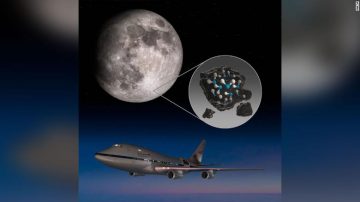
NASA detected traces of water on the sunlit surface of the moon with the use of a space aircraft called the “Stratospheric Observatory for Infrared Astronomy” (SOFIA). Details regarding this astounding discovery were first presented in a journal called “Nature Anatomy” and through a NASA press conference that occurred on October 26, 2020.
SOFIA is a “Boeing 747SP aircraft” that carries a 2.7-meter telescope and has the potential to travel at elevated altitudes of up to 45,000 ft, in which it can reach above 99% of the Earth’s atmosphere’s water vapor. NASA’s aircraft picked up a wavelength of 6.1 microns that is distinctive to water molecules, in one of the craters within the bounds of the moon’s sunlit surface called the “Clavius Crater” by utilizing its “Faint Object infraRed CAmera”.
Past missions regarding the investigation of the contents of the moon’s surface detected a molecule that shared similarities to the structure of a hydrogen atom, however, failed to differentiate its contents between water (H2O) and its close chemical relative, hydroxyl (OH).
In addition, it was discovered that the Sahara Desert possesses one hundred times more water than the lunar surface. In defiance of its modicum, the discovery has been conducive to sundry questions such as how the water is processed, and how it is capable of persisting in an airless climate.
Astronomers have proposed a myriad of factors that could be accountable for the presence, contrivance, or the remittance of water on the moon. Some have asserted that micrometeorites raining on the moon’s surface carrying quantities of water could leave traces of water on the moon’s surface upon impact. Another speculation was concerning solar winds, consisting of hydrogen molecules that may have been delivered to the moon and experienced a chemical reaction with oxygen-bearing minerals found within the lunar soil, creating hydroxyl (OH). Furthermore, radiation from lunar micrometeorites may have possibly transformed the hydroxyl contents into H20.
Theories regarding the accumulation of water or how water is stored on the moon included conjectures with relevance to water being amassed in a myriad of tiny bead-like structures within the moon’s soil, most likely formed by high heats of micrometeorite deluge, or water being cumulated between grains of lunar soil in permanently shadowed areas of the moon.

Juliana Z., a Chinese teacher at AISG believed that the finding of water on the moon may be monumental for the survival of space pilots and future space explorations in the long term. “If there is water available on the moon, it will not have to be expensively transported from Earth. In addition, if the moon had enough water, it could be used for rocket fuel and living materials for astronauts and serve as a foothold for human deep-space exploration. This historic discovery may lead to the development of techniques for collecting and decomposing water resources [on the moon], as well as further research into interstellar traveling and life science.”
A Grade 6 student, Daniel K. expressed his optimistic outlook on the discovery of water on the moon. He rejoiced by suggesting that the discovery of water molecules on the moon could by any means, function as a foundation for the possible construction of efficient space cities. “The presence of water will increase the probability of creating a habitable environment for life forms. Water on the moon would aid to supply quantities of water resources for these life forms or potential space establishments.”
Contrastive to the responses made by Juliana Z. and Daniel K., Ye Ji L., a freshman, supposed that the topical finding of water on the mood could possibly help to replace deficient water supplies on Earth. “If the Earth starts to lack water, water could possibly be extracted from the moon’s surface and employed for efficacious uses down on Earth.”
Mission Apollo conducted in 1969, confirmed that the lunar surface did not possess the adequate factors necessary for it to sustain life and water and portrayed the moon as a desolate and lifeless planet. Past space explorations such as NASA’s Orbital and Impactor Mission detected ice near the permanently shadowed regions of some lunar craters near the moon’s poles. Other past space missions including Cassini, Deep Impact Comet, India’s Space Research Organization (ISRO)’s Chandrayaan – 1 Mission, and NASA’s Infrared Telescope Facility (ITF) detected the presence of water on the moon’s surface; however, couldn’t differentiate its contents between H2O and OH.
NASA has indicated that new flights with SOFIA will be re-facilitated. SOFIA will conduct additional flights in alternative sunlit areas of the moon, including during its disparate phases, and will continue to look deeper into how water is produced and stored on the moon’s surface.